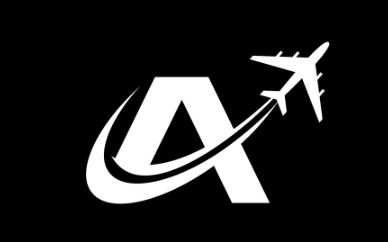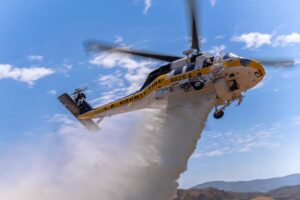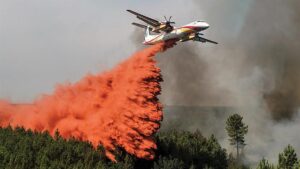
By: Kelly Andersson. FIreAviation.com
After 21 years as a fire pilot, Williams Lake’s Guy Ridler still enjoys his job flying an airtanker. Besides the obvious benefit supporting firefighters on the ground, he says he enjoys the constant variety that aerial firefighting entails.
“No fire is the same,” he recently told Ruth Lloyd with the Williams Lake Tribune. With changing geography, winds, fuel types, and fire activity, he says it is always a challenge to put retardant where the client wants it — and do it safely.
How did he end up where he is, an aerial firefighter who spends his time off in the Cariboo region of British Columbia?
When Guy Ridler was just a young boy, he flew with his parents to Ontario from Newfoundland to visit family. It was his first flight — and he loved it. When he spotted a uniformed pilot in the airport, he approached the “grizzled” pilot and asked him, “How do I get your job?”
The pilot replied with a question of his own. “Well kid, do your parents have a lot of money?”
When Guy said no, the pilot told him, “Then join the Air Force.”
Years later when he was applying to universities, with grades good enough to go anywhere he chose, a teenage Guy applied and was accepted to the Canadian Armed Forces and a spot at Royal Roads Military College near Victoria, B.C.
But he also had his heart set on competing in the Canada Summer Games that year as a cyclist on Team Newfoundland, and the military would not grant him leave to attend. Against the advice of his advisor, Guy turned down his spot at Royal Roads to compete in the Summer Games and instead attend Memorial University of Newfoundland (MUN) for one year, planning to reapply for the military the following year.
He was accepted at MUN, and all these years later, he says his military college experience was very different from what he’d experienced at MUN, and despite the challenges, he considered it a job he had to do to get the education and training he wanted.
After completing military pilot’s training — and obtaining a degree in physics — Ridler graduated and landed a job at the Comox Air Force Base, where he flew a Buffalo for the Search and Rescue team. He flew to airshows all over the continent to drop parachutists and also flew them on SAR missions on Canada’s coast.
After his 11 years of required military service, he left for commercial flying. Ridler was hired on as a copilot on a Conair DC-6, and his captain told him, “You are no longer a pilot, you are now a museum curator,” given that the now-retired DC-6 tankers were first built in the 1940s.

He says the job is 100 percent operational — it’s all about safety and a focus on hazards, to be as effective and as safe as possible — for the airtanker, the crew, and those on the ground. And it’s all VFR. “People think it’s some big high-tech operation,” he says. “But in the end, it’s a lot of experience, on-the-job experience.”
Over the years, Ridler has worked alongside forestry agencies in Alaska, Alberta, British Columbia, Washington state, and even Australia. He’s flown not only airtankers but also birddogs — referred to as lead planes in the U.S.
In 2004 he moved to Williams Lake for his first year as a copilot flying a Convair. He later become a captain, which sent him to Alaska for a number of seasons, but returned to Williams Lake seven years later as the captain of the birddog aircraft.
He thinks the smaller and more maneuverable birddog, which carries the air attack officer, is the best way to learn the job. He completed training as a pilot on the 4-engine RJ85 jet airtanker, and began spending his summers based in Kamloops, then moved back to Williams Lake in 2020.
Link: https://fireaviation.com/2023/09/27/canadian-fire-pilot-loves-his-work/




